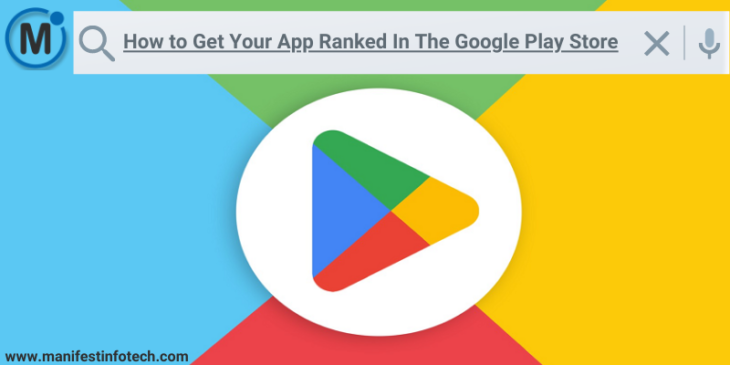
Getting your app ranked in the Google Play Store involves a combination of optimizing your app’s visibility, increasing its downloads, and providing a great user experience. Here are the steps you can take to improve your app’s chances of ranking higher in the Play Store:
𝟏. 𝐀𝐩𝐩 𝐒𝐭𝐨𝐫𝐞 𝐎𝐩𝐭𝐢𝐦𝐢𝐳𝐚𝐭𝐢𝐨𝐧 (𝐀𝐒𝐎):
– Keywords: Research and choose relevant keywords that users might use to search for apps similar to yours. Incorporate these keywords in your app title, description, and metadata.
– Title: Create a clear and descriptive app title that includes your main keyword.
– Description: Write a compelling and informative app description that highlights its features, benefits, and unique selling points.
– Icon and Screenshots: Design an eye-catching app icon and use high-quality screenshots to showcase your app’s user interface and features.
– Video Preview: If possible, create a video preview of your app to demonstrate its functionality and appeal to potential users.
𝟐. 𝐇𝐢𝐠𝐡-𝐐𝐮𝐚𝐥𝐢𝐭𝐲 𝐀𝐩𝐩:
– Develop an app that is well-designed, user-friendly, and provides a valuable solution to users’ needs or problems.
– Ensure your app is stable, free of bugs, and responsive across various devices and screen sizes.
𝟑. 𝐏𝐨𝐬𝐢𝐭𝐢𝐯𝐞 𝐑𝐚𝐭𝐢𝐧𝐠𝐬 𝐚𝐧𝐝 𝐑𝐞𝐯𝐢𝐞𝐰𝐬:
– Encourage users to leave positive reviews and ratings for your app. Respond to user feedback and address any issues they might have.
– Positive reviews and high ratings contribute to your app’s credibility and visibility in the Play Store.
𝟒. 𝐄𝐧𝐠𝐚𝐠𝐞 𝐔𝐬𝐞𝐫𝐬:
– Provide regular updates with new features, improvements, and bug fixes. Active maintenance shows that your app is actively supported and adds to user satisfaction.
– Engage users through in-app notifications, relevant content, and personalized experiences.
𝟓. 𝐏𝐫𝐨𝐦𝐨𝐭𝐢𝐨𝐧 𝐚𝐧𝐝 𝐌𝐚𝐫𝐤𝐞𝐭𝐢𝐧𝐠:
– Promote your app through various channels such as social media, your website, and online communities.
– Consider running ads on platforms like Google Ads to increase visibility and drive downloads.
𝟔. 𝐋𝐨𝐜𝐚𝐥𝐢𝐳𝐞𝐝 𝐂𝐨𝐧𝐭𝐞𝐧𝐭:
– Translate your app’s description, keywords, and other metadata into different languages to reach a broader audience.
– Adapt your app’s content to cater to the cultural preferences and needs of different regions.
𝟕. 𝐔𝐬𝐞𝐫 𝐄𝐧𝐠𝐚𝐠𝐞𝐦𝐞𝐧𝐭 𝐚𝐧𝐝 𝐑𝐞𝐭𝐞𝐧𝐭𝐢𝐨𝐧:
– Focus on user retention strategies to keep users engaged with your app over time. This can include features like rewards, notifications, and in-app content.
𝟖. 𝐀𝐩𝐩 𝐏𝐞𝐫𝐟𝐨𝐫𝐦𝐚𝐧𝐜𝐞:
– Optimize your app’s performance to ensure fast loading times and smooth user interactions. Slow or glitchy apps may lead to user dissatisfaction.
𝟗. 𝐔𝐬𝐞𝐫 𝐅𝐞𝐞𝐝𝐛𝐚𝐜𝐤 𝐚𝐧𝐝 𝐈𝐭𝐞𝐫𝐚𝐭𝐢𝐨𝐧:
– Continuously gather user feedback and insights to identify areas for improvement. Regularly update your app based on user suggestions and needs.
𝟏𝟎. 𝐃𝐚𝐭𝐚 𝐀𝐧𝐚𝐥𝐲𝐬𝐢𝐬:
– Monitor and analyze app store analytics to track user engagement, acquisition channels, conversion rates, and other relevant metrics. Adjust your strategies accordingly.
If you are looking for any services related to Website Development, App Development, Digital Marketing and SEO, just email us at nchouksey@manifestinfotech.com or Skype id: live:76bad32bff24d30d
𝐅𝐨𝐥𝐥𝐨𝐰 𝐔𝐬:
𝐋𝐢𝐧𝐤𝐞𝐝𝐢𝐧: linkedin.com/company/manifestinfotech
𝐅𝐚𝐜𝐞𝐛𝐨𝐨𝐤: facebook.com/manifestinfotech/
𝐈𝐧𝐬𝐭𝐚𝐠𝐫𝐚𝐦: instagram.com/manifestinfotech/
𝐓𝐰𝐢𝐭𝐭𝐞𝐫: twitter.com/Manifest_info
#AppRanking #GooglePlayStore #AppVisibility #ASO #AppOptimization #AppPromotion #MobileAppSuccess #AppMarketing #AppDownloads #UserEngagement #AppStoreOptimization #AppStoreStrategy #AppStoreTips #AppStoreInsights #AppStoreSuccess #AppStoreGrowth #MobileAppSEO #AppRankBoost #AppStoreAnalytics #AppRatings #AppReviews #AppRetention #MobileAppQuality #AppPerformance #AppDevelopmentTips #AppPromo #AppStorePromotion #AppStoreMarketing #AppLaunchStrategy #AppStoreAlgorithm